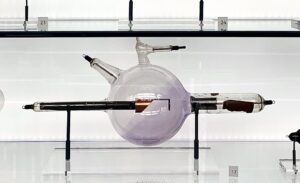X-rays
‘X-rays were discovered in 1895 using a Crookes tube, a piece of equipment widely used in Physics laboratories. After this discovery a huge range of designs were tried to see which worked best.’
Half of the glass of this tube has turned purple through radiation damage. Many of the tubes show this effect in brown or purple.
It started off as just an idea, something helpful and useful, something that was needed and essential. Idea itself is the first stage of an object. I can imagine the idea being altered and improved, however the idea might have been inefficient and unpractical, the design would be changed in the future.
Sand, limestone and soda ash were put together, melted at very high temperature to form a new material – glass. That is a chemical transformation. It behaved like solids but looked like liquid, it was shaped into something specific, shape that came from the idea. This specific piece of material was manipulated and handled by a person, who is confident in themself, who knows what the idea was and how to execute it. It is a transformation, a tedious process.
This tube was touched by human hands, handled by various people and was probably seen as perfect. Thin strand of the metal was added by another person, it had to be finished. It was a tungsten filament, later it would glow very brightly when an electric current passed through it. It was an important step. Many other details were added for it to work.
It was made in early 20th century, in the USA by Macalister Wiggins Inc. X-ray tube was created. It functions as a specific energy converter. People talked about it.
It started to work. X-ray tube was receiving electrical energy and converted it into two other forms of energy: x-radiation and heat. This vacuum tube produced x-rays. It could have been used in various machines.
It was not the final stage, something new was created and the x-ray tube was replaced. It was affected and damaged by radiation, the colour has changed. Half of the glass of this tube has turned purple.
It did not break, it was saved and carefully handled. Maybe it was forgotten but later found and preserved by somebody interested. Many hands touched it.
Now it is on display in the National Museum of Scotland. It is looked at and photographed. Not functioning, just being an interesting object to observe.


Leave a Reply